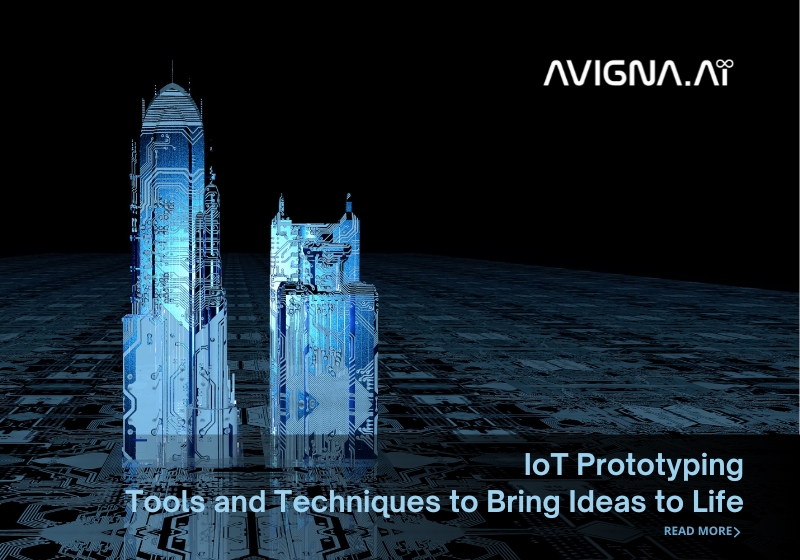Whether you’re envisioning the home of the future or developing innovative solutions for smart cities, one thing is sure – ideas alone will not make an impact. One needs a hands-on approach to validate assumptions and refine solutions to transform concepts into reality and deliver actual value. This is where IoT prototyping comes in. By creating preliminary models and gathering user feedback, one can progress ideas through a series of iterations into fully-fledged products and systems. In this article, I will walk you quickly through various IoT prototyping tools and techniques essential for prototyping, paving the way for ideas to be brought to life.
Why Prototype in IoT?
Have you ever wondered how complicated IoT systems like home security or agricultural technology work behind the scenes? While the vision seems straightforward, building a robust infrastructure involving sensors, devices, networks, and software integrations takes time and effort. It also ensures design feasibility while identifying flaws early on, minimizing risks before significant investments are made. Most importantly, prototyping enables user-centered product development through iterative testing and feedback.
IoT Prototyping Techniques
By comprehensively validating IoT ideas, today’s innovators can progress concepts more accurately and confidently. With continuous refinement, the IoT prototyping techniques will continue revolutionizing how collaborative innovations are brought to life.
Wireframing and Sketching
The initial phase involves sketching ideas without unnecessary details through wireframing. This brings conceptual clarity and serves as a common language between teams. IoT wireframes capture core functionalities like sensors, device specifications, connectivity aspects, UI design, and data flow.
Mockups and Proof of Concept Models
Mockups bring visual form to abstract ideas with static representations at this stage. They aid in refining user experience and interface design aspects. Proof of concept models focuses on evaluating key technical concepts through simulated components and programming. This technique is commonly used to prove sensor integration possibilities or test communication protocols.
Rapid Prototyping
Once basic validations are complete, the next step involves developing rapidly iterated working models using tools like breadboards, sensors, and microcontrollers. This accelerates the learning process through quick experimentation and modification cycles. The intent here is rapid iteration rather than finished products.
Functional Prototyping
Closely resembling intended products but without high production standards, functional prototypes simulate realistic user testing scenarios. They aid in identifying issues relating to performance, data handling, and practical use cases before investments are made in manufacturing.
IoT Prototyping Tools
Over the years, easily accessible IoT prototyping tools have transformed how concepts are tested and progressed. Here are some of the essential tools in an IoT prototype’s arsenal:
- Arduino – An open-source platform for building electronics projects through simple coding. It supports the rapid development of sensor-integrated breadboard prototypes with extensive library support.
- Raspberry Pi – A low-cost yet powerful single-board computer used as an IoT development hub, hosting operating systems, programming languages, and connectivity. It supports quick application development.
- ESP 32/8266 – Inexpensive yet feature-rich Wi-Fi-enabled microcontroller boards ideal for prototyping connected devices. Onboard radios facilitate rapid testing of wireless integrations.
- Fritzing – A free circuit diagramming and breadboard sketching software for visualizing IoT hardware setups and circuits virtually before building physical versions.
- Tinker CAD – A browser-based circuit design tool focusing on 3D modeling of sensor-integrated prototypes for evaluating form factor designs. Great for mechanical aspects.
- Arduino IDE – The standard software interface for coding, building, and uploading programs to Arduino boards. It supports all integrated development workflows.
- Android/iOS Simulators – Software based emulations of target mobile platforms useful for app prototyping outside physical devices.
- Adobe XD/Figma – Feature-rich UX/UI interface design and prototyping platforms catering to visual and interactive interface ideations and validations.
Suggested Reading: How do IoT Consulting Services Help Your Business?
Taking IoT Prototyping to the Next Level
While the basics of IoT prototyping techniques cover evaluating core technologies, validating solutions from a strategic business perspective is also essential. Today, many IoT startups and enterprises invest additional efforts upfront to simulate real-life deployment scenarios, even at early stages.
Business Model Prototyping
Beyond technical grounds, leveraging IoT prototyping techniques like customer journey mapping and value proposition design helps strengthen the commercial viability of IoT platforms and use cases. Focusing on practical factors like target segments, pricing, distribution, and partnerships leads to well-grounded strategic planning.
Service Design Prototyping
Simulating complete customer and operational experiences from onboarding to troubleshooting aids in identifying post-sale requirements. This involves visualizing processes like installations and repairs through mock walkthroughs and workflows.
Multidisciplinary Teams
Including experts spanning vertical domains, programming, and business optimizes prototypes to cater to multifaceted needs. Interactions with end users and operations staff enrich outputs to cover nuanced requirements.
Rapid Deployment Simulation
Techniques like containerization facilitate emulating IoT solutions close to target infrastructure and scale before real deployments. This identifies bottlenecks and optimizes systems for seamless transitions.
Bringing Ideas to Life Through Constant Iteration
Iterating prototypes based on continuous evaluation and input is fundamental to realizing the incredible potential of IoT. But how exactly can this process of refinement be undertaken effectively? The following guidelines provide a tested framework.
- Define Objectives and Requirements: Establishing goals and must-have features upfront anchors every iteration.
- Commence with Low-fidelity Testing: Rapidly test core concepts through cheap sketches and paper prototypes before investing in complex builds.
- Gradually Increase Fidelity: As understanding and vision solidify, move to interactive click-throughs and fully functional prototypes.
- Gather Comprehensive Feedback: Acquire input from diverse users, experts, and partners to surface varied perspectives through contextual inquiries and usability testing.
- Prioritize Most Impactful Changes: Not all feedback warrants action—focus iterations on resolving critical problems or adding substantial value.
- Document Learnings after Each Session: Tracking insights and changes preserves knowledge to apply to future projects.
Receive Prototyping Guidance from Team Avigna
The IoT prototyping helps evaluate the challenges of transforming abstract notions into fully-fledged realities. Your IoT concepts progress through incremental improvements into final products by leveraging the right workflow tools covering hardware, software, and user experience. With the development of advanced tooling, the barriers to prototyping innovative solutions are constantly reducing, bringing ideas to life with greater accessibility and success.
At Avigna, we specialize in helping innovators attain their IoT success with our IoT consulting. Contact us or email us at queries@avigna.ai to consult with our experts. Follow us on LinkedIn.




